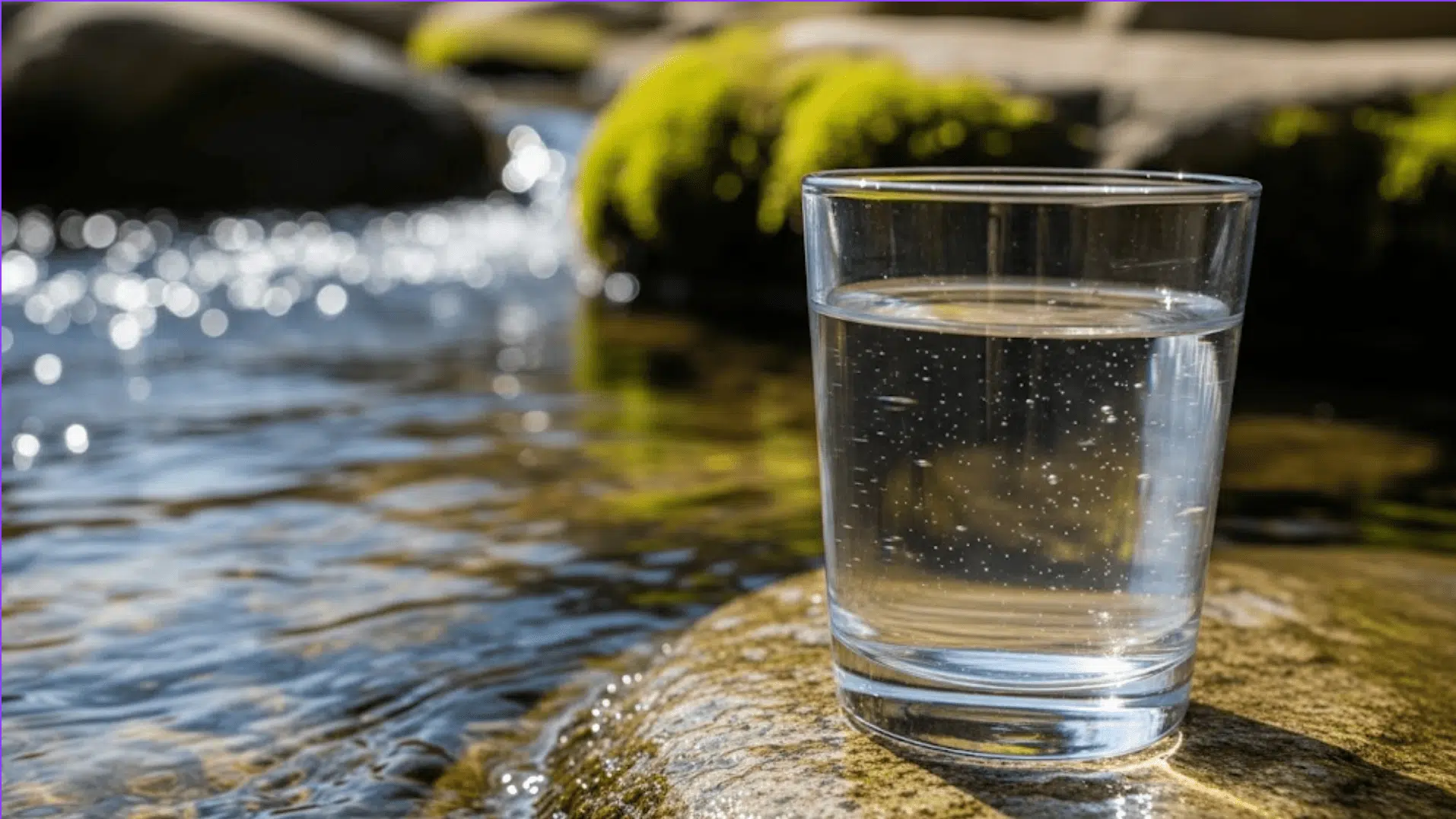Does spring water have minerals that make it different from regular tap water flowing from your kitchen faucet? Spring water comes naturally from underground sources that flow up through the earth’s surface without artificial processing.
I’ll explain everything you need to know about spring water’s mineral content, amazing health benefits, and important safety considerations. You’ll learn why so many people choose spring water over other hydration options for their daily drinking needs.
I’ll also compare spring water with mineral water so you can make the smartest choice for your family. By the end, you’ll be a spring water expert who knows exactly what you’re drinking every day. Let’s make hydration simple and smart!
Why So Many People Prefer Spring Water
Spring water has become incredibly popular because it tastes fresh and clean without any chemical aftertaste.
Many people love that it comes straight from natural underground sources without heavy processing. The crisp, refreshing flavor makes drinking water more enjoyable throughout the day.
You might notice spring water feels lighter and smoother than tap water when you drink it. This natural taste comes from flowing through rocks and soil for years underground. Beyond taste, spring water provides real health benefits through its natural mineral content.
The calcium supports strong bones, while magnesium and potassium keep your muscles and nerves working properly. These same minerals help maintain proper hydration and may even support heart health by potentially reducing blood pressure.
Does Spring Water Contain Minerals?


Yes, spring water does contain minerals, though the amounts vary depending on where it comes from. The mineral content makes spring water different from pure distilled water, which has everything removed.
Common minerals you’ll find in spring water include calcium, magnesium, potassium, sodium, and bicarbonates. These naturally occurring elements give spring water its distinctive taste and potential health benefits.
The minerals get into spring water through an amazing natural process underground. As water flows through rocks and soil layers, it slowly picks up dissolved minerals along the way.
Different geological areas create different mineral profiles in the water. This natural filtration can take months or even years to complete.
Mineral Profiles in Spring Water
I’ll break down the key minerals you’ll find in spring water and how they benefit your health. You can see how each mineral varies by location and why your body absorbs them so easily.
1. Calcium
Calcium in spring water typically ranges from about 4 to 575 mg/L, varying widely by location. It is a vital mineral for bone health and muscle function.
Spring waters with moderate to high calcium content, such as Vittel Hépar from France (~575 mg/L), provide a natural source that can contribute significantly to dietary intake. Its bioavailability in ionic form allows easy absorption in the gastrointestinal tract.
2. Magnesium
Magnesium content in spring water generally falls between 1 mg/L to around 128 mg/L. Many European bottled spring waters contain moderate amounts, such as Robacher from Germany (~128 mg/L).
Magnesium supports muscle and nerve function and energy production. The ionic form in spring water enhances bioavailability, making it an effective supplementary source alongside food.
3. Sodium
Sodium concentrations in spring water show substantial variability, ranging from less than 1 mg/L to over 1,400 mg/L. For example, Kaiser Friedrich in Germany contains about 1,419 mg/L, which is very high.
Sodium in spring water contributes to electrolyte balance but should be monitored in low-sodium diets. Absorption from water is rapid due to its dissolved ionic state.
4. Potassium
Potassium is usually present in lower concentrations, often below 50 mg/L in spring water. Although less abundant than calcium or magnesium, potassium supports heart and muscle function.
Its ionic form in spring water enables efficient absorption, helping contribute to daily potassium needs when consumed regularly.
5. Iron
Iron is typically found in trace amounts in spring water, often less than 1 mg/L. It can vary depending on geological conditions. Iron is essential for oxygen transport in the blood.
While the low levels of water may provide a minor contribution, bioavailability in spring water is often higher than that from dietary sources due to its ionic form.
6. Zinc
Zinc is present in trace quantities in spring water, generally less than 0.1 mg/L. It plays roles in immune function and enzyme systems.
Though spring water contributes only a small fraction to daily zinc requirements, the mineral’s ionic form supports effective absorption in the body.
Mineral Water vs Spring Water – What’s the Difference?
Understanding the key differences between spring water and mineral water helps you choose the right option for your needs.
I’ll show you how these two popular water types compare across source, regulations, and taste:
| ASPECT | MINERAL WATER | SPRING WATER |
|---|---|---|
| Source | Deep underground sources with naturally occurring minerals | Natural underground springs that flow to the surface |
| Regulation | Must contain at least 250 ppm Total Dissolved Solids (TDS) per FDA rules | No minimum mineral requirement by the FDA |
| Taste | Distinct, sometimes stronger taste due to higher mineral content | Light, crisp, and refreshing with subtle mineral notes |
| Processing | Cannot have minerals added artificially; must be naturally occurring | Minimal processing to maintain natural characteristics |
| Mineral Content | Consistently higher mineral levels, always above 250 ppm TDS | Variable mineral levels depending on source location |
| Availability | Often imported, premium pricing due to specific mineral requirements | More commonly available and typically less expensive |
These differences explain why you might prefer one type over the other based on taste and health goals.
Both options offer natural hydration, but mineral water provides a guaranteed higher mineral content for your daily intake.
Is Spring Water Safe?
Spring water can be a healthy and refreshing choice, but its safety depends on the source and processing.
While reputable brands follow strict regulations, unverified sources can pose risks. Here’s what you should know:
- Reputable brands are generally safe: Most undergo testing and filtration to remove harmful bacteria and contaminants.
- FDA regulations apply: Bottled spring water must meet quality and safety standards set by the Food and Drug Administration.
- Beware of unregulated sources: Some cheaper or unknown brands may skip thorough testing or mislabel tap water as spring water.
- Check labeling details: Look for the actual spring source location and company information on the bottle.
- Stick to trusted names: Established brands with good reputations are more likely to follow proper safety protocols.
By choosing reliable brands and checking product labels, you can enjoy spring water with confidence while avoiding potential risks.
Wrapping It Up
You now understand that spring water contains beneficial minerals like calcium, magnesium, and potassium for better overall health and wellness.
I’ve shown you how these essential minerals support your bones, muscles, and heart function naturally without any artificial additives.
Spring water offers a pure, clean taste without harsh chemicals while providing important nutrients your body needs daily.
Safety depends on choosing reputable brands that follow proper testing standards and honest labeling practices.
The choice between spring water and mineral water comes down to your personal taste preferences and mineral requirements.
Next time someone asks, “does spring water have minerals,” you can confidently explain the amazing benefits these natural nutrients provide. Ready to make the healthy switch? Comment below and share your findings!









